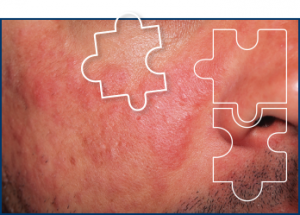
Dr P. Marazzi / Science Source
A recent study explored medical concerns for patients who have lupus markers, but fall short of meeting enough criteria for official disease classification.
Investigators at the Oklahoma Medical Research Foundation conducted a large study to explore current treatments of patients with incomplete lupus erythematous (ILE) and to compare antibody characteristics to healthy people and patients with classified lupus. The study results appeared in the December issue of the journal Arthritis Care and Research.1
The nature of ILE remains poorly understood, and no definition or treatment recommendations for it exist, says Judith James, MD, PhD, vice president of clinical affairs at the Oklahoma Medical Research Foundation in Oklahoma City. Patients with ILE have clinical features of lupus, but don’t meet four or more criteria required under the ACR classification for systemic lupus erythematous (SLE), says Dr. James.
“For this study, we used the term ‘incomplete lupus erythematosus’ to mean the patient met three ACR classification criteria for lupus. However, ILE has also been defined as having a positive blood test plus at least one or two clinical features of lupus,” she says.
ILE patients are usually referred to a rheumatologist initially because a doctor suspected lupus or other autoimmune disease and a blood screen showed positive for antinuclear antibodies (ANAs), says Dr. James. These patients may also present such symptoms as rash, mouth sores, photosensitivity, joint pain and swelling.
In this nationwide study, researchers recruited participants through the Lupus Family Registry and Repository and examined medical records for common symptoms and medications. They used the SLE portion of the Connective Tissue Disease Screening Questionnaire to gather demographic, clinical and self-reported symptoms from participants, and measured autoantibodies to examine immunologic features.

Dr. James
Most study participants were women, and the ILE group tended to be slightly older than those in the SLE group. There were more white participants than other races, followed in number by African American and Hispanic.
In a group of 440 ILE patients given the questionnaire, the respondents reported the same number of SLE symptoms whether they were patients with major clinical manifestations of the disease or patients with minor manifestations. These symptoms included pleurisy and protein in the urine, as well as seizure.
The same questionnaire was given to 3,397 patients with SLE, who reported slightly more symptoms than patients with ILE (6.4 vs. 5.9). Both groups reported more SLE-related symptoms than people in a control group.
Some of the most common ACR classification criteria reported by ILE patients included ANA positivity, immunologic disorder, arthritis and hematologic disorder.
“ILE patients usually had milder forms of disease and so had more cutaneous manifestations or arthritis and less severe manifestations, [such as] renal disease or pericardial effusions,” says Dr. James.
Nearly one in five of the ILE patients had major clinical manifestations, and the rate ran higher in African Americans (25.7%) compared with European Americans (14.9%), according to the article.
Some ILE patients had major clinical manifestations that also appeared in the SLE patients, such as serositis, renal disease, hemolytic anemia and thrombocytopenia. These patients used more medication types and more major immunosuppressants than other ILE patients, according to the article.
Which Medications?
Because no standard treatment recommendations exist for ILE patients, researchers wanted to investigate what medications were used to treat their illness. Study results showed these patients often took the same drugs, such as hydroxychloroquine and corticosteroids, commonly prescribed to classified lupus patients, says Dr. James.
“The thing we found that was slightly surprising was that a subset of individuals who meet three criteria for lupus are receiving immunosuppressive medications or even major immunosuppressive medication …,” she says. “If we knew the ILE patients were not at risk of developing major organ involvement, they might be able to be treated with less toxic medications.”
Information gaps regarding ILE patients is also a research concern, says Dr. James. “Even though our study shows the clinical symptoms the ILE patients have … may be milder than what we think of in systemic lupus, their ILE symptoms as well as their [symptoms] that aren’t part of the classification criteria are definitely impairing their quality of life,” says Dr. James.
Results from serologic testing show ILE patients had fewer autoantibodies and that concentrations were lower when compared with the classified lupus patients. In addition, levels of the B lymphocyte stimulator (BLyS), a protein associated with autoantibody production in lupus, were also lower in ILE patients compared with the SLE group.
A subset of ILE patients (36%) had significantly elevated levels of BLyS, and those patients may warrant closer monitoring for future risk of classified SLE. Many lupus patients have elevated levels of BLyS, but the biomarker previously had not been studied in an ILE population, says Dr. James.
“Maybe that would be another marker that would help rheumatologists when they are evaluating patients with a positive ANA who do not yet meet all the ACR criteria for lupus,” she says.
Rheumatologists must remember the classification criteria were developed for use in clinical trials, not as a diagnostic tool.
Preventing Disease Escalation

Dr. Buyon
Dr. James says this research lays a foundation for future studies to identify patients with ILE who shouldn’t be treated with high doses of prednisone or major immunosuppressive drugs if their disease isn’t likely to progress past two or three non-
organ-threatening SLE criteria.
“We think this is an interesting group of people to study so we can understand whether they have regulatory mechanisms in their immune system that can help stop the progression to full-blown systemic lupus. Or are there environmental factors, healthy lifestyle choices or things they have that helps protect them to keep them from transitioning [to lupus]?” says Dr. James.
Jill Buyon, MD, director of the Lupus Center at New York University Langone Medical Center in New York City, says the study encourages “us to think about the spectrum of the disease … what protects and what promotes it.” However, she prefers to avoid labels and instead focus on what specific symptoms or signs comprise the diagnosis.
“In this paper, the ‘I’ or ‘S’ is not the relevant adjective,” says Dr. Buyon. “It’s not about the label, but about the seriousness of the manifestation. That’s what we want to prevent.”

Dr. Sheikh
Rheumatologists must remember the classification criteria were developed for use in clinical trials, not as a diagnostic tool even though they are inadvertently used for that purpose, says Saira Sheikh, MD, director of Clinical Trials and the Rheumatology Lupus Clinic at the University of North Carolina, Chapel Hill, Thurston Arthritis Research Center.
“We need to be thoughtful of the care of the individual patient regardless of whether or not they meet the classification criteria for SLE. Classification criteria help identify homogenous patient sets for enrollment in clinical trials and can’t be applied across the board to the care of individual patients, especially because lupus is such a heterogeneous disease,” says Dr. Sheikh.
Karen Costenbader, MD, MPH, lupus program director at Brigham and Women’s Hospital in Boston, Mass., and a professor of medicine at Harvard Medical School, notes that some patients in the ILE group who were treated with major immunosuppressants may have been diagnosed with SLE without meeting the classification for it.

Dr. Costenbader
“It could be that some of those people, but not all, would develop into classified lupus,” says Dr. Costenbader, who co-wrote an editorial accompanying the study. “This type of study is trying to identify people who are at risk for developing lupus so we can find them earlier, we can study the pathogenesis of disease to see what’s happening early in the blood, in biomarkers and risk factors and genetics … so we can possibly prevent [disease escalation].”
Says Dr. Sheikh, “That’s something we need to explore further: What aspect of the immune profile of these patients is unique and could help the practicing rheumatologist determine how to better take care of patients? That’s really the goal.”
Catherine Kolonko is a medical writer based in Oregon.
Reference
- Aberle T, Bourn RL, Munroe ME, et al. Clinical and serologic features in patients with incomplete lupus classification versus systemic lupus erythematosus patients and controls. Arthritis Care Res (Hoboken). 2017 Dec;69(12):1780–1788.


